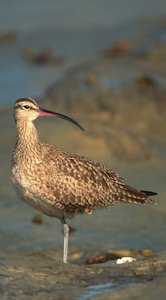
|
Bird Foraging Behaviors - Page 2 But it is a false picture, since the evolution of bird bills has proceeded in step with the evolution of bird foraging behaviors and diets. There is, however, a difference between the evolution of bill shapes and that of foraging behavior: Behavior can be much more variable than bill shape. A bird trying to adapt to different foods in different seasons or in different localities has no choice but to use the bill it was given. But it can acquire many different foraging behaviors, each suited to a particular food source or habitat. Whimbrels and Hudson Godwits, for example, can use their long bills to peck at insects on arctic tundra plants during the summer, as well as probe for small invertebrates in the mud of a coastal estuary during the winter. These pecking and probing behaviors have evolved for these situations, and each bird must learn how to probe deeply for different prey and how to follow tide lines in order to obtain the most food. To a great extent, the kinds of food available determine the feeding behaviors of birds. A particular kind of food may exist in many different situations requiring different feeding techniques, For example, many birds feed on insects, but their methods vary depending on whether the insects are found on tree bark, in tree litter, or on surface vegetation, in rotting wood, in the soil, underwater, or flying through the air. |
| Whimbrel |